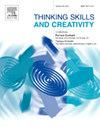How do teachers and students creatively engage within the classroom?
IF 3.7
2区 教育学
Q1 Social Sciences
引用次数: 0
Abstract
The present study explores a systemic approach to creativity based on componential models in education and the possible effects of personal and social factors on students’ expected creative behavior. It investigated how distinct components like Motivation, Knowledge, Openness, and Environment contribute to creativity. To this end, an online questionnaire was developed using the Experimental Vignette Methodology to manipulate the components and was administered to teachers from Brazil and Portugal (N = 115). Results indicated that teachers in both countries see the social environment (80 %) as the most important predictor of student creativity compared to the other components. For some teachers (20 %), instead of the social environment, Openness is the most important component. We conclude by advocating for a broader understanding of creativity in educational assessments, emphasizing the importance of inclusive learning environments that foster a growth mindset and acknowledge diverse forms of creative participation, in order to promote a positive learning environment for creative development.
教师和学生如何在课堂上创造性地参与?
本研究探索了一种基于教育组件模型的系统方法,以及个人和社会因素对学生预期创造性行为的可能影响。它调查了动机、知识、开放性和环境等不同的组成部分对创造力的贡献。为此,研究人员使用实验小插图方法编制了一份在线问卷,对来自巴西和葡萄牙的教师进行了调查(N = 115)。结果表明,与其他因素相比,两国的教师都认为社会环境(80%)是学生创造力最重要的预测因素。部分教师(20%)认为开放性是最重要的因素,而不是社会环境。最后,我们提倡在教育评估中更广泛地理解创造力,强调包容性学习环境的重要性,以培养成长型思维,并承认多种形式的创造性参与,以促进创造性发展的积极学习环境。
本文章由计算机程序翻译,如有差异,请以英文原文为准。
求助全文
约1分钟内获得全文
求助全文
来源期刊

Thinking Skills and Creativity
EDUCATION & EDUCATIONAL RESEARCH-
CiteScore
6.40
自引率
16.20%
发文量
172
审稿时长
76 days
期刊介绍:
Thinking Skills and Creativity is a new journal providing a peer-reviewed forum for communication and debate for the community of researchers interested in teaching for thinking and creativity. Papers may represent a variety of theoretical perspectives and methodological approaches and may relate to any age level in a diversity of settings: formal and informal, education and work-based.
 求助内容:
求助内容: 应助结果提醒方式:
应助结果提醒方式:


